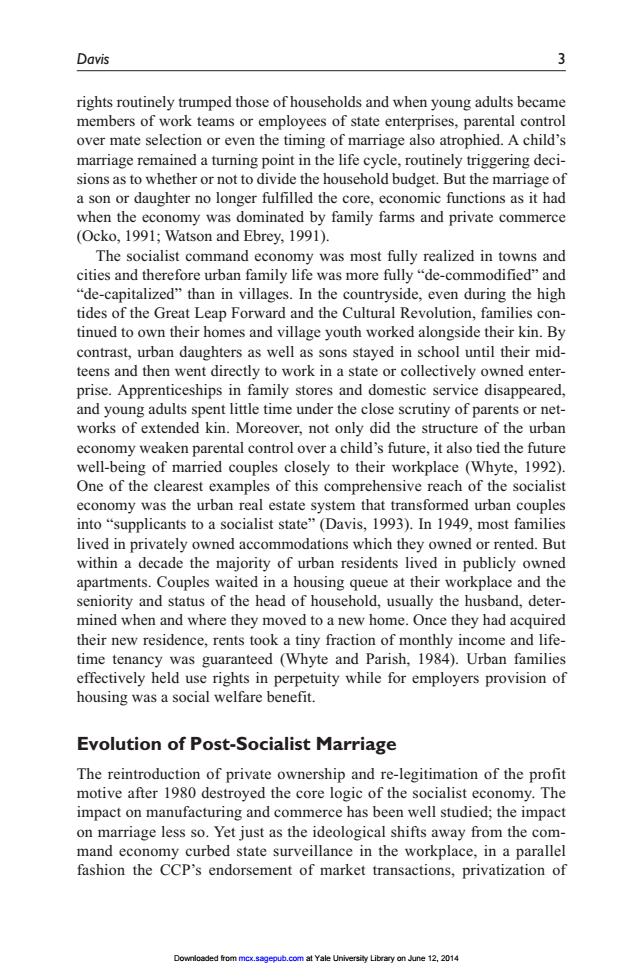正在加载图片...

Davis 3 rights routinely trumped those of households and when young adults became members of work teams or employees of state enterprises,parental control over mate selection or even the timing of marriage also atrophied.A child's marriage remained a turning point in the life cycle,routinely triggering deci- sions as to whether or not to divide the household budget.But the marriage of a son or daughter no longer fulfilled the core,economic functions as it had when the economy was dominated by family farms and private commerce (Ocko,1991;Watson and Ebrey,1991). The socialist command economy was most fully realized in towns and cities and therefore urban family life was more fully "de-commodified"and "de-capitalized"than in villages.In the countryside,even during the high tides of the Great Leap Forward and the Cultural Revolution,families con- tinued to own their homes and village youth worked alongside their kin.By contrast,urban daughters as well as sons stayed in school until their mid- teens and then went directly to work in a state or collectively owned enter- prise.Apprenticeships in family stores and domestic service disappeared, and young adults spent little time under the close scrutiny of parents or net- works of extended kin.Moreover,not only did the structure of the urban economy weaken parental control over a child's future,it also tied the future well-being of married couples closely to their workplace (Whyte,1992). One of the clearest examples of this comprehensive reach of the socialist economy was the urban real estate system that transformed urban couples into "supplicants to a socialist state"(Davis,1993).In 1949,most families lived in privately owned accommodations which they owned or rented.But within a decade the majority of urban residents lived in publicly owned apartments.Couples waited in a housing queue at their workplace and the seniority and status of the head of household,usually the husband,deter- mined when and where they moved to a new home.Once they had acquired their new residence,rents took a tiny fraction of monthly income and life- time tenancy was guaranteed (Whyte and Parish,1984).Urban families effectively held use rights in perpetuity while for employers provision of housing was a social welfare benefit. Evolution of Post-Socialist Marriage The reintroduction of private ownership and re-legitimation of the profit motive after 1980 destroyed the core logic of the socialist economy.The impact on manufacturing and commerce has been well studied;the impact on marriage less so.Yet just as the ideological shifts away from the com- mand economy curbed state surveillance in the workplace,in a parallel fashion the CCP's endorsement of market transactions,privatization of Downloaded from mcx.sagepub.com at Yale University Library on June 12,2014Davis 3 rights routinely trumped those of households and when young adults became members of work teams or employees of state enterprises, parental control over mate selection or even the timing of marriage also atrophied. A child’s marriage remained a turning point in the life cycle, routinely triggering decisions as to whether or not to divide the household budget. But the marriage of a son or daughter no longer fulfilled the core, economic functions as it had when the economy was dominated by family farms and private commerce (Ocko, 1991; Watson and Ebrey, 1991). The socialist command economy was most fully realized in towns and cities and therefore urban family life was more fully “de-commodified” and “de-capitalized” than in villages. In the countryside, even during the high tides of the Great Leap Forward and the Cultural Revolution, families continued to own their homes and village youth worked alongside their kin. By contrast, urban daughters as well as sons stayed in school until their midteens and then went directly to work in a state or collectively owned enterprise. Apprenticeships in family stores and domestic service disappeared, and young adults spent little time under the close scrutiny of parents or networks of extended kin. Moreover, not only did the structure of the urban economy weaken parental control over a child’s future, it also tied the future well-being of married couples closely to their workplace (Whyte, 1992). One of the clearest examples of this comprehensive reach of the socialist economy was the urban real estate system that transformed urban couples into “supplicants to a socialist state” (Davis, 1993). In 1949, most families lived in privately owned accommodations which they owned or rented. But within a decade the majority of urban residents lived in publicly owned apartments. Couples waited in a housing queue at their workplace and the seniority and status of the head of household, usually the husband, determined when and where they moved to a new home. Once they had acquired their new residence, rents took a tiny fraction of monthly income and lifetime tenancy was guaranteed (Whyte and Parish, 1984). Urban families effectively held use rights in perpetuity while for employers provision of housing was a social welfare benefit. Evolution of Post-Socialist Marriage The reintroduction of private ownership and re-legitimation of the profit motive after 1980 destroyed the core logic of the socialist economy. The impact on manufacturing and commerce has been well studied; the impact on marriage less so. Yet just as the ideological shifts away from the command economy curbed state surveillance in the workplace, in a parallel fashion the CCP’s endorsement of market transactions, privatization of Downloaded from mcx.sagepub.com at Yale University Library on June 12, 2014